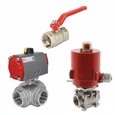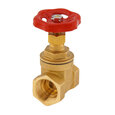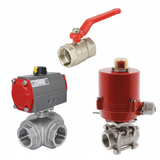Gate Valves vs Ball Valves

Figure 1: Ball valve (left) and gate valve (right)
Gate and ball valves both control the flow of liquids and gases but differ in design, operation, and application. Ball valves are ideal for quick shut-off and tight sealing, making them suitable for gas and chemical handling. Gate valves are better for high flow capacities and high-pressure environments, such as large pipelines and water distribution systems. This article explores their differences and how to choose between them.
Table of contents
View our online selection of ball valves and gate valves!
Gate valve vs ball valve
Due to the differences between gate and ball valve operation and design, each has advantages and disadvantages.
Table 1: Ball valve vs gate valve
| Criteria | Ball valve | Gate valve |
| Shut-off mechanism | Fast shut-off with only a quarter turn (90-degree turn) to close the valve. | Slow shut-off and requires more than a 360-degree turn to shut off the valve. |
| Water hammer | Fast opening and closing may cause water hammer. | Slow opening and closing reduces the risk of water hammer. |
| Visual detection | The open or closed state of the valve can be visually detected with the handle position. | Difficult to detect the open or closed state of the valve. |
| Cost | Typically more expensive than a gate valve of the same specifications. Durable and requires less maintenance, potentially more economical long-term. | Typically cheaper than a ball valve of the same specifications. |
| Installation space | Requires more space than a gate valve to accommodate a quarter-turn handle. | Requires relatively less installation space than a ball valve. |
| Size | Better suited for bore sizes below 2" (50.8 mm) | Better suited for bore sizes above 2" (50.8 mm) |
| Leakage | Provides a tight seal even if used after a long period. | More prone to leaks than a ball valve. |
| Durability | Durable and less prone to damage. | The valve stem can be prone to corrosion, making the valve less durable. |
| Ports | Can have more than two ports, allowing for more complex flow paths. | Typically has two ports. |
| Flow capacity | Generally offers smaller flow capacity due to smaller diameters. | Provides larger flow capacity, typically offered in larger diameters. |
| Opening and closing speed | Better suited for applications requiring fast operation or emergencies. | Slower operation due to multiple turns required. |
| Sealing | Provides a tight seal, ideal for applications like natural gas. | Less effective sealing compared to ball valves. |
| Pressure | Suitable for low-pressure applications, fast operation may cause water hammer in high-pressure systems. | Better suited for high-pressure applications. |
Operation differences
Ball valve
A ball valve uses a rotary ball with a bore and a stem (Figure 2). When the handle attached to the stem is turned, it rotates the ball to open or close the valve. This valve is also called a quarter-turn valve because the handle only needs a 90𐩑 turn (quarter turn) to allow or block the flow of the media. The valve is open when the handle is parallel to the pipe and closed when the handle is perpendicular to the pipe. For a more in-depth analysis of ball valves, view our ball valve technical article.
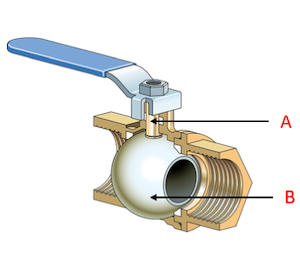
Figure 2: Ball valve stem (A) and rotary ball (B)
Gate valve
A gate valve uses a gate to control the flow of the media. A gate is a solid disk structure connected to the stem, as seen in Figure 3. The gate is lifted to open the valve and returned to its original position to close it. The valve is accompanied by a bonnet, which, when rotated, controls the position of the gate. This valve is also called a multi-turn valve because it takes more than a 360° turn to open or close it entirely. For a more in-depth analysis of gate valves, view our gate valve technical article.
Learn more about different handle types in our differences between lever handles and handwheel handle valves article.
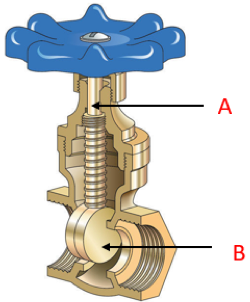
Figure 3: Gate valve stem (A) and gate (B)
Gate valve and ball valve applications
Both ball valves and gate valves are commonly used in residential and industrial applications.
- Gate valves are generally found in older plumbing systems and applications where frequent shut-off is not required. Large water supply lines use gate valves due to their straight flow path and fewer flow restrictions. Ball valves are increasingly used in new plumbing systems with frequent shut-off requirements.
- Gate valves are preferred for slurries and viscous media applications because they are easier to clean and maintain. Ball valves are less desirable because they are difficult to clean, and slurry particles may damage the rotary ball.
- Gate valves are used in power plants, mining, and water treatment applications in high-temperature and high-pressure environments.
- Ball valves are commonly used in fire protection systems and marine applications. They are best avoided in food, beverage, and pharmaceutical applications as they are challenging to clean and may cause contamination.
FAQs
Which is better: a gate valve or a ball valve?
It depends on the application. A ball valve is better suited for lower flow rates, requiring more than two ports, or for durability/sealing concerns. A gate valve is typically cheaper, better for higher flow rates, and requires a smaller installation space.
What is the difference between a gate valve and a ball valve?
The main difference is in operation. A gate valve moves a solid disk up and down to open or close the orifice. A ball valve rotates a ball (the orifice) with a bore in it 90 degrees to open or close the valve.
What is a ball valve used for?
A ball valve controls the flow and is typically used as a shut-off valve.
When would you use a gate valve?
A gate valve is ideal for applications with slurries, significant flow rates, cost sensitivity, and for shut-off purposes.




